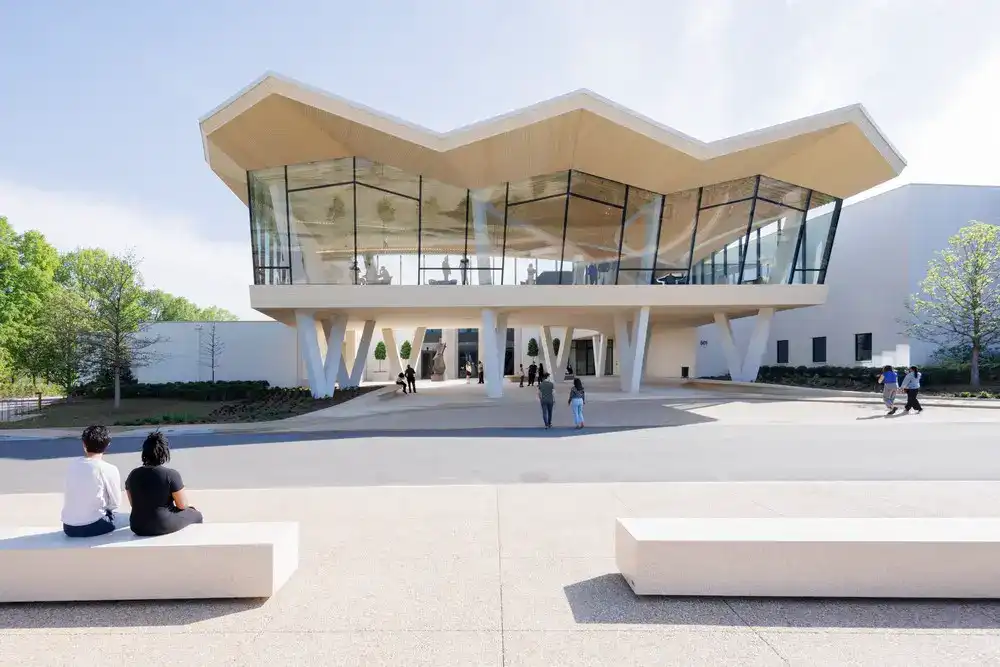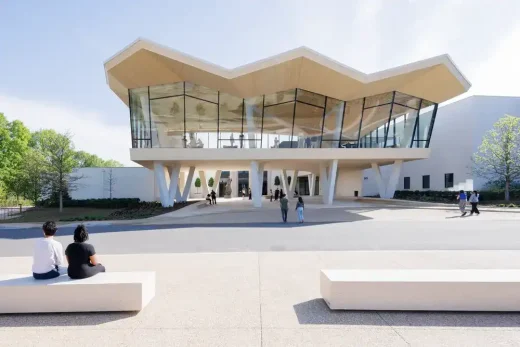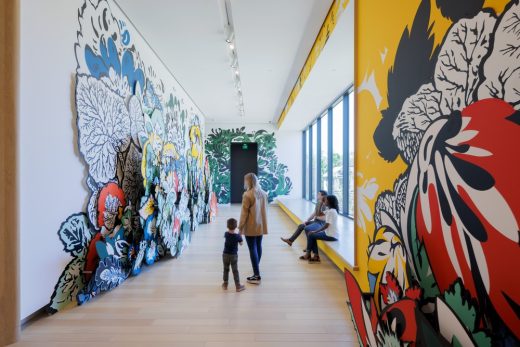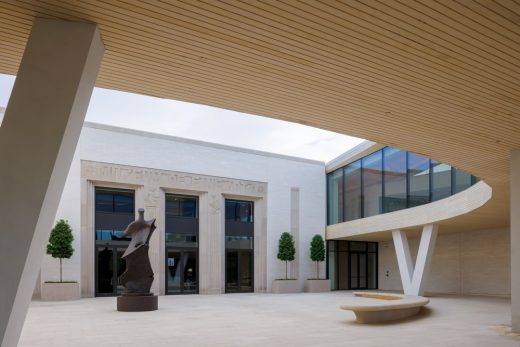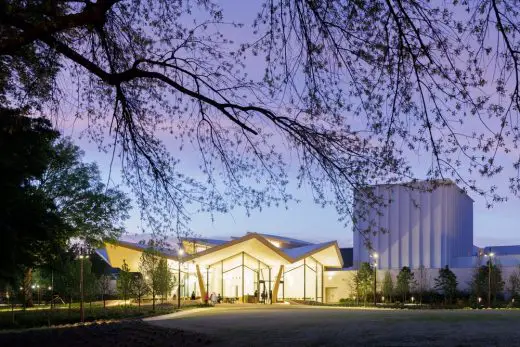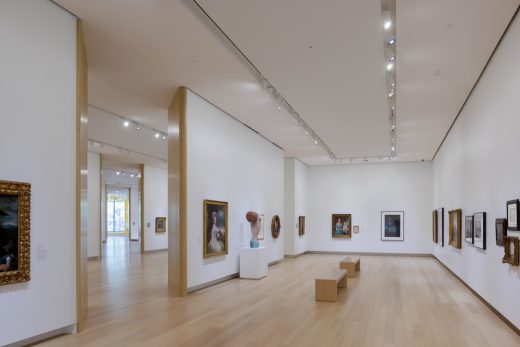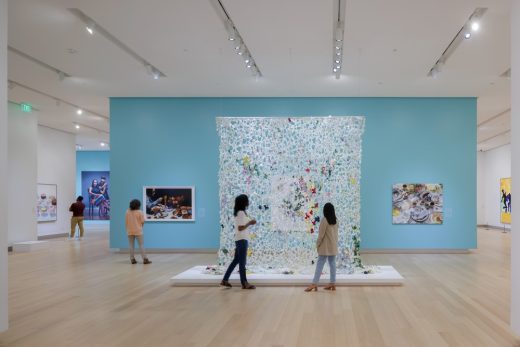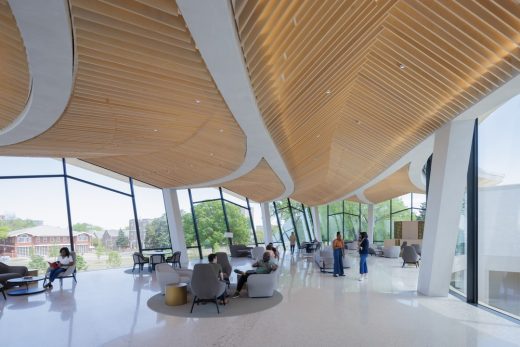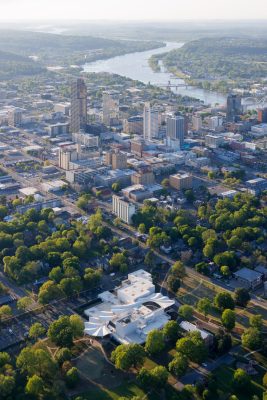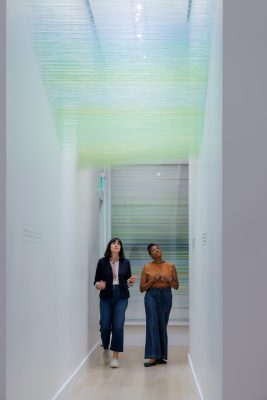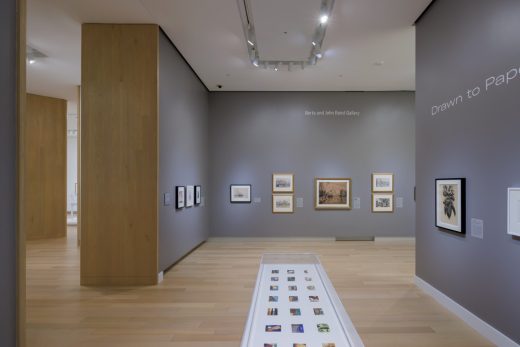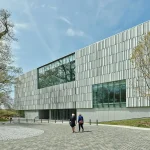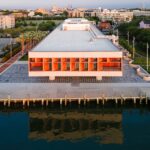Little Rock Art Museum Arkansas, Modern USA gallery building design, American architecture photos
Little Rock Art Museum in Arkansas
May 12 + Apr 21, 2023
Architects: Studio Gang
Location: 501 East Ninth Street, Little Rock, Arkansas 72202
Photos © Iwan Baan
Little Rock Art Museum, USA
Studio Gang’s First Art Museum Opens in Little Rock, Arkansas
The design for the Arkansas Museum of Fine Arts unifies existing spaces with a new central addition, transforming the museum facilities and visitor experience.
In a newly transformed building designed by Studio Gang, the Arkansas Museum of Fine Arts (AMFA) will re-open on April 22, 2023. The museum, which was founded in 1937, has been closed to the public since 2019 while it underwent its major expansion and renovation. The project, which is Studio Gang’s first completed art museum, renews existing spaces and introduces a new central addition for the museum.
Studio Gang’s design creates a 133,000-square-foot building that embraces the surrounding city and park while also establishing a bold new architectural identity for AMFA. The design revitalizes the Museum’s eight existing structures, which were built in different eras and architectural styles, by reconfiguring them in a way that allows them to work together as a cohesive building. Its new addition runs through the center of the entire building like a stem, unifying and reorganizing the Museum’s existing functions and enabling a seamless flow through the building and across the site.
“The Arkansas Museum of Fine Arts has been a beloved community anchor since its founding, but over time its main additions had resulted in a building that was isolated from the neighborhood and park,” says Jeanne Gang, Founding Principal and Partner of Studio Gang. “We saw the design as an opportunity to reconnect the building with its surroundings and to reimagine the existing structures in ways that would welcome visitors and all of the vibrant, creative activities going on inside would be supported.”
By establishing and clarifying connections between the museum’s diverse programs, the design transforms the visitor experience and greatly improves daily operations. The new central addition connects directly to the museum’s galleries, which will display elements from the permanent collection as well as temporary exhibitions; the Windgate Art School, which includes eight new art studios for students of all ages and skillsets in drawing, painting, ceramics, glass, metals, woodworking, printmaking; and the 350-seat Performing Arts Theater. It also offers connections to the museum’s research collections center, lecture hall, and restaurant.
At each end, this central stem appears to blossom outward, opening the museum to its surroundings and welcoming the public in. To the north is the Cultural Living Room, a hovering, transparent volume that serves as a community gathering space and as a beacon that welcomes visitors to AMFA. To the south, the deep overhangs of the folded-plate roof create a sheltered dining terrace for the new indoor-outdoor Park Grill restaurant that steps down to meet MacArthur Park. Both inside and outside, the organic, curving form responds directly to the constraints of the existing structure and foundations, which were substantially preserved as part of the design’s sustainable approach.
The design also treats architecture and landscape as intrinsically linked. An 11-acre renewed landscape, designed by SCAPE, extends the Museum experience into the outdoors, bringing a biodiverse array of new plantings that provide shade and beauty for indoor/outdoor social spaces, as well as new paths that allow the public to enjoy nature and view outdoor sculptures.
In addition to providing shade, bringing natural light into the interior, and improving the building’s energy performance, the distinctive pleats on the Museum’s roof are also designed to direct rainwater into the rain gardens next to the building. These gardens capture and filter the water before distributing it throughout the MacArthur Park landscape and, eventually, into Foster Pond at the south end of the site.
AMFA marks the latest example of Studio Gang’s ongoing commitment to the creative reuse of existing buildings. To mitigate the impact of embodied carbon in architecture, the firm actively looks for ways to reimagine structures that already exist – from sensitive additions to existing museum campuses to reinventions of industrial buildings. Reuse is an ongoing focus of Jeanne Gang’s teaching as a Professor in Practice at the Harvard Graduate School of Design. It also is a key project in Studio Gang’s growing portfolio of cultural work, which also includes the upcoming Richard Gilder Center for Science, Education, Innovation at the American Museum of Natural History– set to open its doors May 4, 2023.
Studio Gang was awarded the AMFA project through a design competition in 2016. The project broke ground in 2019. The project was supported by a $155 million capital campaign, which included a $31 million contribution from the City of Little Rock.
The museum will mark the opening with a weeklong series of events, including a ribbon-cutting ceremony at 10 AM CT on Saturday, April 22nd. For more information, see AMFA’s website.
About Studio Gang
Founded and led by MacArthur Fellow Jeanne Gang, Studio Gang is an architecture and urban design practice headquartered in Chicago with offices in New York, San Francisco, and Paris. Driven by an ethos of “actionable idealism”, the Studio uses an iterative, research-based design process to create places that build stronger relationships among people, communities, and the natural world.
Studio Gang’s diverse portfolio includes award-winning projects that range from cultural institutions like Writers Theatre to mixed-use towers like Aqua and strategic framework plans. Ongoing projects throughout the Americas and Europe include a new United States Embassy in Brasília; a unified campus for the California College of the Arts; and a new Global Terminal at O’Hare International Airport. The Richard Gilder Center for Science, Education, and Innovation, the firm’s addition to the American Museum of Natural History in New York, will open to the public on May 4, 2023.
Regularly named one of Fast Company’s Most Innovative Architecture Companies, Studio Gang has been internationally honored, published, and exhibited. The Studio’s most recent monograph, Studio Gang: Architecture was published by Phaidon in both French and English editions.
Little Rock Art Museum in Arkansas, USA – Building Information
Architect: Studio Gang – https://studiogang.com/
Principal Project Funders
AMFA – https://www.arkmfa.org/ – is being realized through a capital campaign that includes a $31,245,000 contribution from the City of Little Rock, generated through a hotel tax revenue bond. Overwhelming private support has more than quadrupled this public contribution to the project. Lead donors include Windgate Foundation, Harriet and Warren Stephens, Terri and Chuck Erwin, the State of Arkansas, and Winthrop Rockefeller Charitable Trust.
Project Team:
Studio Gang
Jeanne Gang, Founding Principal and Partner
Juliane Wolf, Design Principal and Partner
Margaret Cavenagh, Design Principal, Interiors
Angela Peckham, Senior Project Leader
Design Team: Paige Adams, Jill Doran, Emily Licht, AJ Rosales, Stanley Schultz, David Swain, Rolf Temesvari, Peter Yi, and Wen Zhou
SCAPE
Kate Orff, Founding Principal and Partner
Gena Wirth, Design Principal and Partner
John Donnelly, Technical Principal and Partner
Chris Barnes, Project Manager and Landscape Architect
Tanner Perrin, Deputy Project Manager and Landscape Architect
Polk Stanley Wilcox
David Porter, Principal and CEO
Cindy Pruitt, Principal
Design Team: Wendell Kinzler, Laura Hendrix, Dian Bartlett, and Kate Edwards
Additional Team
Nabholz, Pepper, Doyne, Construction Manager/General Contractor
Thornton Tomasetti, Structural Engineer and Enclosure Consultant
McClelland Consulting Engineers, Civil Engineer
dbHMS, MEP/FP Engineer
Arup, Acoustical, Theatrical, and AV Designer
Venue Consulting, Cost Estimator
Licht Kunst Licht, Lighting Designer
Brownlee and Mann Consulting
501 East Ninth Street, Little Rock, Arkansas 72202.
AMFA is in the heart of downtown’s historic MacArthur Park.
Photographer © Iwan Baan
Studio Gang Architects, Chicago, IL, USA
Little Rock Art Museum, Arkansas, USA images / information received 210423 from Studio Gang Architects
Location: Little Rock, Arkansas, United States of America
Buildings in Arkansas
Contemporary Bentonville Buildings
Design: Wheeler Kearns Architects
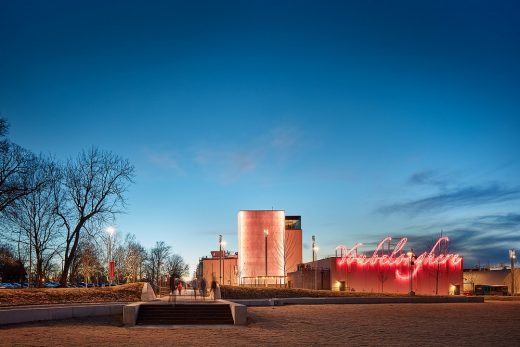
photograph : Tom Harris Architectural Photography
The Momentary in Bentonville
Design: Marlon Blackwell Architects
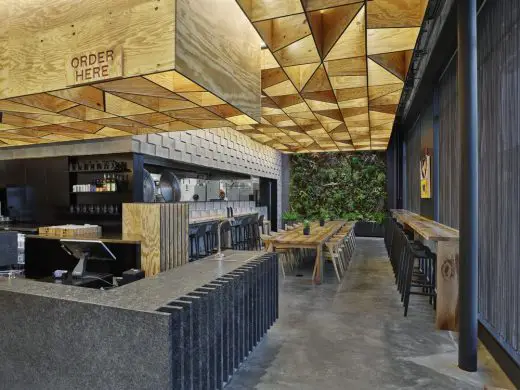
photo : Timothy Hursley
CO-OP Ramen Restaurant in Bentonville
Crystal Bridges Museum of American Art Bentonville
Crystal Bridges Museum of American Art
New Arkansas Architectural Projects
Design: Matthias J Pearson Architect
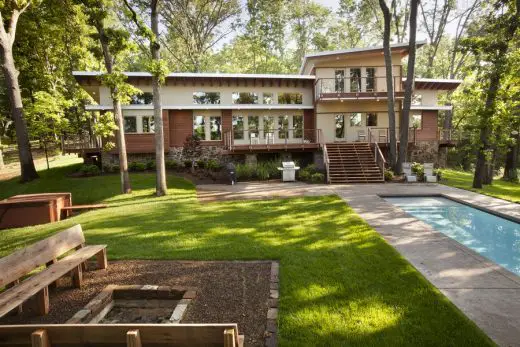
photograph : Timothy Hursley
Residence in Bella Vista
Design: Marlon Blackwell Architects
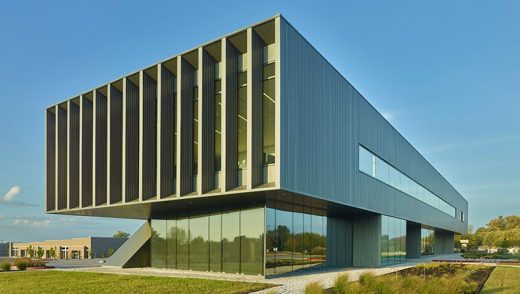
photograph : Timothy Hursley
Clinic Building in Rogers
Saint Nicholas Antiochian Orthodox Christian Church
Buildings in Neighbouring States to Arkansas
Buildings / photos for the Little Rock Art Museum, Arkansas, USA designed by Studio Gang Architects page welcome

